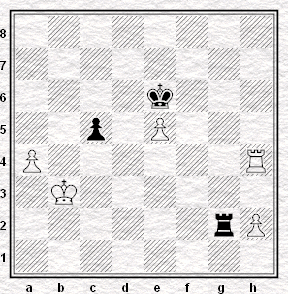1.c4 e6 2.d4 d5 Kasparov says that you cannot become a strong player without playing the Ruy Lopez (yesterday's game) or the Queen's gambit declined (today). 3.Nc3 c6 Anand uses the triangle against Carlsen's English opening, and Carlsen avoids heavy semiSlav theory with 4.e4 dxe4 5.Nxe4 Bb4+ 6.Nc3 (the more common move is 6.Bd2) 6...c5 7.a3 Ba5 8.Nf3 Nf6 9.Be3 Nc6 10.Qd3 cxd4 11.Nxd4 Ng4 with this novelty the game slips out of history and we are in new territory.
12.O-O-O Nxe3 13.fxe3 Bc7 14.Nxc6 bxc6 15.Qxd8 Bxd8. It looks like we have a long endgame ahead
Black has several soft spots. The c6-pawn and the c6 and d6 squares. This is a comfortable type of position for Carlsen. It is likely that Carlsen will be able to force the trade of his knight for Anand's dark square bishop leaving a good vs bad bishop ending. This is likely another two result endgame for Carlsen.
16.Be2 Ke7 17.Bf3 Bd7 18.Ne4 Bb6 19.c5 f5 20.cxb6 fxe4 21.b7 Rab8 22.Bxe4 Rxb7
Carlsen has his slightly better game with the good versus bad bishop, but black only has one weakness, and usually one needs two weaknesses to work against to win an endgame. One problem that Carlsen has is the black's c6 pawn is indirectly defended by a pin/fork with a rook against white's king on the c-file.
23.Rhf1 Rb6 24.Rf4 seems to allow black to play e6-e5 with tempo on the rook making more squares available to black's bishop, but Anand chooses 24...g5 25.Rf3 h7-h5
Anand gains space while eliminating a target on h7; he is slowly removing his pawns from squares available to white's bishop. 26.Rdf1 Be8 27.Bc2 Rc5 28.Rf6 h4 29.e4 Carlsen limits the scope of his bishop, and could be a problem if black gets e5 in first. a5 30.Kd2 Rb5 31.b3 Bh5 32.Kc3 Rc5+ 33.Kb2 Rhd8 Anand is down to 14 minutes with 7 moves to play. 34.R1f2 Rd4 35.Rh6 Bd1 36.Bb1 Carlsen avoids the trade of bishops 36...Rb5 37.Kc3 c5 38.Rb2 e5
Anand has removed his pawns from light squares, and Carlsen has the bad bishop. It looks like things have turned completely around. Carlsen does have an active rook in compensation. 39.Rg6 (39.Bd3 fails to Rxb3+ 40.Rxb3 Bxb3 41.Kxb3 Rxd3) a4 40.Rxg5 Rxb3+ 41.Rxb3 Bxb3 Rxe5+ Kd6 43.Rh5 Rd1 44.e5+ Kd5 45.Bh7 Rc1+ 46.Kb2 Rg1 47.Bg8+ Kc6
Carlsen takes a long think. He likely is trying to decide to play Rh6+ or not. The key is what squares he wants to allow the black king. 48.Rh6+ Kd7 This might be a key mistake. The a-pawn might be very fast. (48...Kb5 49.Bxb3 axb3 50.Kxb3 Rxg2 51.Rxh4 and black still has the possibility of control of all of white's pawns.) 49.Bxb3 axb3 50.Kxb3 Rxg2 51.Rxh4 Ke6 52.a4
With the black king centralized, white must push the outside pawns. The a4-pawn is defended by the h4-rook, which allows the white king to get more active if black's king moves to the wing, or the a-pawn can keep advancing if black takes the e-pawn. 52...Kxe5 53.a5 Kd6 This looks winning for white. 54.Rh7 Kd5 55.a6 c4+ 56.Kc3 Ra2 57.a7 Kc5 58.h4 1-0







No comments:
Post a Comment